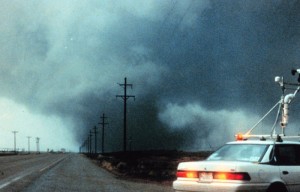
A collaborative nationwide project exploring the origins, structure and evolution of tornadoes will occur from May 10 through June 13 in the central United States. The project, Verification of the Origins of Rotation in Tornadoes EXperiment2 (VORTEX2 or V2), is the largest and most ambitious attempt to study tornadoes in history and will involve more than 50 scientists and 40 research vehicles, including 10 mobile radars.
“Data collected from V2 will help researchers understand how tornadoes form and how the large-scale environment of thunderstorms is related to tornado formation,” according to Louis Wicker, research meteorologist with NOAA’s National Severe Storms Laboratory and V2 co-principal investigator.
Scientists will sample the environment of supercell thunderstorms – violent thunderstorms capable of producing damaging winds, large hail, and tornadoes – that form over more than 900 miles of the central Great Plains. Areas of focus include southern South Dakota, western Iowa, eastern Colorado, Nebraska, Kansas, the Texas panhandle and western Oklahoma. The V2 Operations Center will be at the National Weather Center in Norman, Okla.
Preliminary results from V2 are scheduled for presentation at Penn State University during fall 2009. At that time, organizers will begin planning details of the second phase of V2 scheduled for May 1 – June 15, 2010.
V2 is a $11.9 million program funded by NOAA and the National Science Foundation, 10 universities, and three non-profit organizations.
The original VORTEX program, operated in the central Great Plains during 1994 and 1995, documented the entire life cycle of a tornado for the first time in history. Recent improvements in National Weather Service severe weather warning statistics may be partly due to the application of VORTEX findings. V2 will build on the progress made during VORTEX and further improve tornado warnings and short-term severe weather forecasts.
“An important finding from the original VORTEX experiment was that the factors responsible for causing tornadoes happen on smaller time and space scales than scientists had thought,” said Stephan Nelson, NSF program director for physical and dynamic meteorology. “New advances will allow for a more detailed sampling of a storm’s wind, temperature and moisture environment and lead to a better understanding of why tornadoes form – and how they can be more accurately predicted.”
Scientists and students throughout the United States, Canada, and Australia that will work with the V2 program include the Center for Severe Weather Research, Rasmussen Systems, NOAA National Severe Storms Laboratory, OU/NOAA Cooperative Institute for Mesoscale Meteorological Studies, NSF-sponsored National Center for Atmospheric Research, Penn State University, University of Oklahoma, Texas Tech University, Lyndon State College, University of Colorado, Purdue University, North Carolina State University, University of Illinois, University of Massachusetts, University of Nebraska, Environment Canada, and the Australian Bureau of Meteorology.
For a complete list of participating scientists, and to learn more about the experiment, visit the V2 site and the official project Web site ![]() .
.
NSF is an independent federal agency that supports fundamental research and education across all fields of science and engineering, with an annual budget of $6.06 billion. Its funds reach all 50 states through grants to more than 1,900 universities and institutions. Each year, NSF receives about 45,000 competitive requests for funding, and makes over 11,500 new funding awards. NSF also awards over $400 million in professional and service contracts yearly.
NOAA understands and predicts changes in the Earth’s environment, from the depths of the ocean to the surface of the sun, and conserves and manages our coastal and marine resources.
